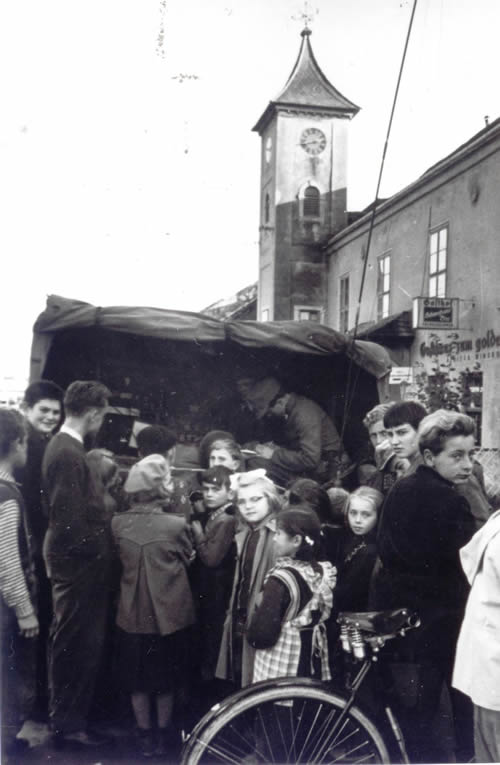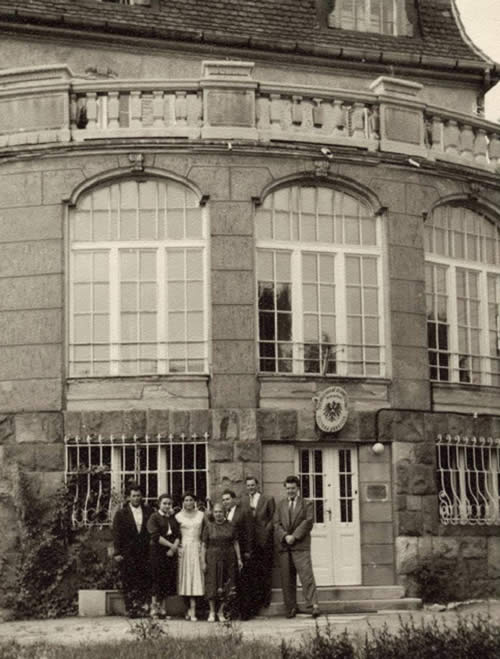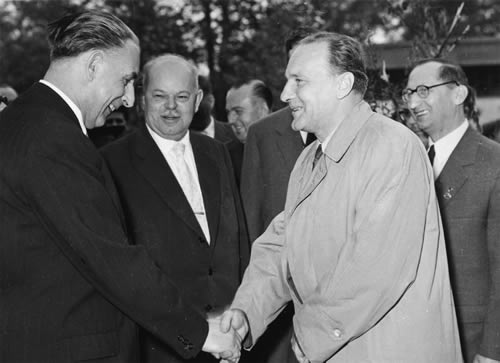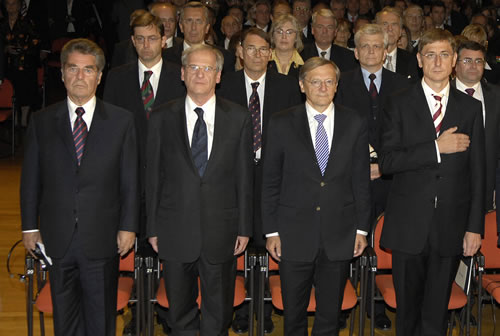Austria and the Hungarian Revolution 1956
by Martin Pammer
On the 50th anniversary of the Hungarian Revolution in 1956, we present a translated article written by Martin Pammer on the special role played by Austria’s diplomatic mission in Budapest at the time of the Hungarian national uprising. It highlights the effects the crisis had on Austria, when implementing its newly gained neutrality by securing its borders and offering humanitarian assistance in Budapest and to Hungarian refugees coming to Austria. The young Austrian Republic emerged as a haven of freedom, democracy and humanity at a time when Europe was divided by the Iron Curtain and sinking back into the Cold War.

Hungarian refugees, 1956. APA-IMAGES/IMAGNO/Barbara Pflaum
The Hungarian Revolution of 1956 provided an unexpected opportunity for Austria to test their newly acquired independence. Just one year before the country had regained its full independence and was confronted with the challenge of fulfilling the conditions of self-declared “neutrality.” The remarkable role played by the Austrian diplomatic mission in Budapest in launching a humanitarian campaign, however, is largely unknown. The following contribution discusses this role based on the historical background leading up to the Hungarian revolution and the existing state of bilateral relations.

Austrian Federal Army at the border offering assistance. Heeresgeschichtliches Museum, Vienna.
The Uprising as a Reaction to the Lack of Reforms and Continuous Stalinist Rule
The year after the signing of the Austrian State Treaty in 1955 was filled with hope in Central Europe. Cold War changes following the death of Stalin in 1953, and Austria’s new position on the international stage exercised a positive effect on the relationship between Hungary and Austria. Until then, the relationship between the two neighbors had been greatly strained. This was due to the assumption of power by the Hungarian Communists after 1946, the clear division of Europe and the subsequent establishment of the Iron Curtain. This together with countless border incidents which caused more than 240 deaths had resulted in the estrangement of elites of the two countries. Once united in the Danube Monarchy, they had now become adversaries.
In 1955 Hungary viewed neutral Austria as a desirable model to emulate and one which had been successful in alleviating Soviet dominance. Despite ideological differences and amid skepticism on the part of Austria, a time of Détente cooperation between Central European countries, based on the concept of peaceful coexistence appeared to be useful and worthwhile to both sides in solving long existing problems. Negotiations were held over property rights and tension caused by the Iron Curtain was eased after mines were cleared and the border fence was removed in 1956. There was even talk of establishing connecting flights between Vienna and Budapest. Further dynamics were brought into play in all of the satellite countries following the end of the 20th Congress of the Soviet Communist Party.
Additional progress seemed to be eminent during the process of further ‘destalinization in Hungary,’ and an increasingly effective opposition from within the party and society began to influence matters. Nevertheless, because reforms were not implemented, economic conditions did not improve and a hesitant Hungarian leadership failed to act, the situation became grave. Dr. Walther Peinsipp, who had headed the Austrian Legation in Budapest since March 1956 as Minister plenipotentiary observed “that the situation in Hungary has become explosive and the opposition is planning to take a considerable risk ...”
Austria’s Humanitarian Assistance during the Revolutionary Fight for Freedom
Members of the Austrian diplomatic mission were surprised by the actual outbreak of the revolution, as was the international community and all of the key players. The people of Austria were overwhelmed by an unprecedented sense of solidarity. This was a deep feeling of sympathy from a people who themselves had experienced ten years of Soviet occupation and a genuine affirmation of the Hungarian demands for freedom and democracy. Despite earlier historical events Austria remained sympathetic toward the Hungarian people, with whom they had shared the same destiny for centuries.

The Austrian Legation in Budapest, 1956.
Hundreds of tons of food, medicine, blood plasma, bandages, clothing, and other supplies were collected and brought to Hungary beginning on October 27. The call for humanitarian assistance happened spontaneously, often without institutional support, directives or a central organization, and especially during those few short days before the Soviets intervened for the second time on November 4. Hundreds of trucks and cars bearing the label of the Red Cross crossed the border, still open at Nickelsdorf, bringing with them donations to Budapest and Györ which were gratefully received by the Hungarian population. Much of the supplies were delivered to various hospitals, schools and homes but a number of volunteers who went to Budapest did not know to whom they should turn.
Four days after the outbreak of the Revolution, the first convoy of trucks drove to the Legation. Believing that Austria’s diplomatic representatives would surely know how, what and to whom the goods would be distributed, they appealed directly to the Head of the Legation, Walther Peinsipp. Without any preparation, the Legation was suddenly confronted with an overwhelming task for which it was ill prepared, either in terms of organization or manpower. Supplies worth about 1.4 million Euros today were stored or distributed to hospitals, the injured or individual doctors by some fifty truck loads. This also happened during the days of combat, often under life-threatening circumstances.
Because there had been no telephone connection between Vienna and Budapest after October 23, it was impossible for the Legation to receive advice from the Foreign Ministry in Vienna. Also, efforts to coordinate humanitarian aid with other organizations in Budapest were unsuccessful. Talks with the Hungarian and the International Red Cross regarding this matter were unproductive. Two deliveries ended up primarily in the hands of authorities loyal to the government, thus, according to Peinsipp, contrary to the desire of the donors, in the hands of the Communists or Soviet troops.
Part of this humanitarian campaign also involved protecting Austrian citizens in Budapest and guaranteeing their return to Austria, and assisting Hungarians willing to flee. At the same time high level contacts with Hungarian authorities sometimes took a dramatic turn. When the last meeting between Prime Minister Imre Nagy and Peinsipp occurred on November 3 in the Hungarian Parliament, Nagy was negotiating for the last time with Jurij Andropow on the phone. Peinsipp personally gave the assurance that the Austrian government was doing everything to prevent the influx of any armed forces into Hungarian territory. This first-time mission of securing the border was carried out by the Austrian Federal Army, established just one year earlier.
The part of the supplies delivered to the Legation containing blood conserves and narcotics were immediately sent on October 27 to the Szent János Hospital, located near the residence of the Austrian Head of Mission in Tapolcsányi Street 1. While developing the logistics of a system of distribution, the supplies remained in the residence and in the official buildings of the Legation in Àrvácska Street 11. This was necessary so that delivery teams could quickly return to Austria.
Their wish to distribute supplies in Budapest was curtailed due to an incident involving a convoy of trucks which came under fire. In the days that followed, many more transports arrived. Finally the storage capacity of the Legation’s buildings had reached the breaking point and a gymnasium in a school located some 300 meters below the residence at Marczibányi Square was used for additional storage.
The distribution of supplies, which was later characterized as a breach of neutrality, continued in various ways and in many phases: Between October 28 and November 11, food, medicine and bandages, depending on need, were delivered to the doctors and mainly young “insurgents” by way of the Head of Legation’s residence. During the first phase of fighting, everything and especially blood donations were immediately brought to the hospitals. After November 4, medical supplies were delivered to specifically designated hospitals with the help of the Hungarian physician, Dr. Georg Ronay. He had fled in 1947 to Austria and had returned to Budapest at the outset of the Revolution accompanied by an aid shipment provided by members of the Order of Malta.
Although this allowed for guaranteed delivery, it was often done under life-threatening circumstances. Peinsipp, for instance, drove the official car to designated places throughout the city with the Austrian red-white-red and also white flags in full view. When the second Soviet intervention began along with the danger of looting, the “warehouse” at Marczibányi Square, guarded by members of the Legation had to be quickly closed. All of the supplies stored there were sent primarily to Szent János Hospital. From November 7 until mid-November, the rest of the supplies, consisting mainly of food, clothing and powdered milk were distributed among the needy.
When the campaign was over it was necessary to counter the accusations in the media directed against Austria for having breached neutrality. Lists of deliveries signed by Hungarian doctors and the International Red Cross were compiled verifying receipt. For those Hungarians who cooperated with the Austrian Legation during the campaign, these official lists provided an important even life-saving protection when the Communist Hungarian National Security began its investigations. Subsequently, these lists were necessary in refuting the accusations against the Legation of having delivered arms and weapons to insurgents.

Dr. Walther Peinsipp and Janos Kadar.
Another major form of assistance was the repatriation of Austrians living in Budapest, along with journalists, and young Hungarians who had participated in the fighting and wished to escape to freedom. In order to avoid being shot and in order to pass through the “insurgents,” Hungarian or Soviet check points, alternative routes were chosen. Red Cross flags were tied to the hood of cars driving in a convoy. The first and last cars in the convoy were decorated with Austrian flags which could be easily seen from a distance. The lead car was the official car from the Legation. Since many of the Hungarians fleeing in the convoys returning to Austria had no passports, such as Maria Potocki, the Secretary of the Socialist politician Anna Kethly and German interpreter for Prime Minister Nagy, Minister Peinsipp issued her and a dozen other Hungarian citizens Austrian passports.
From mid-November 1956 to mid-1957, the activities carried out by the Legation were targeted by the communist media as a breach of neutrality by Austria. The allegation was made that weapons were being delivered to the “insurgents” via the Legation at the same time as supplies were being brought in, contrary to Red Cross rules. In early December of 1956 during the 11th General Assembly of the United Nations, the crisis in Hungary was still the most important topic of debate. Austria’s UN representative, Ambassador Dr. Franz Matsch, in his reply to Soviet accusations, was forced to explain the Legation’s humanitarian campaign in detail.
From Flight and Retaliation to Austrian Ostpolitik
Austria’s position in regard to the question of refugees and their continued involvement in the case of Hungary presented a difficult dilemma for the new incumbent in power, János Kádár. Bilateral relations worsened toward the end of 1956 and in early 1957 when mutual accusations caused even more tension. The relationship between Austria and Hungary reached its lowest point since the Second World War and resulted in the encirclement and isolation of the Legation in Budapest by police and secret service forces.
After February 25, 1957, regular Hungarian police and members of the National Security began controlling the comings and goings of all Hungarian visitors, as well as members of the Austrian, British, French, and American diplomatic missions. Hungarians applying for visas were intimidated, and the missions were prevented from carrying out their work effectively. As a form of punishment for its humanitarian campaign the previous fall, the Austrian Legation became a chosen target and was treated harshly. The streets leading to the entrance of the Mission were cordoned off by about 100 policemen and declared a “military restricted area.”
For almost one week, all Hungarians leaving the Legation were temporarily taken into custody, and interrogated for hours. This action was abandoned only after serious political pressure from Austria who threatened to break off diplomatic relations with Hungary and to shut down the Mission. As was later ascertained by the American journalist, Leslie Bain, Austria’s Legation in Budapest was the only diplomatic representation that carried out any substantial humanitarian action. Thus, the performance of the Austrian Legation can be regarded as a great example of the quality of Austrian diplomatic service. Walther Peinsipp, however, became the “Austrian Hero of Budapest”.
The long-term effects of the year 1956 constituted a turning point in relations between Austria and Hungary. The oppressive “secured” bloc configuration and the special Austrian position paradoxically created the basis for a unique relationship between these two countries with different political systems. Both countries located at this point at the edge of a divided Central Europe within a bipolar world order, were able to establish a limited, but specific range of foreign policy. Non-aligned and neutral Austria and Kádár’s Hungary, which had gained some restricted liberty within the Warsaw Pact drew closer together. This generated a certain friendship making for a second “K. u. K.” (kaiserlich und königlich i.e. imperial and royal) - Kreisky and Kádár. Finally, as a long-term result of Austrian Ostpolitik, Austria and Hungary abolished the compulsory visa in 1974 for the very first time in a divided world.
1956 brought important consequences to Austria in its domestic and, generally, its foreign policy: The two ruling coalition parties, the Austrian People’s Party (ÖVP) and the Social Democratic Party of Austria (SPÖ), moved closer together again while the Austrian Communist Party (KPÖ) was virtually powerless. It was the temporary acceptance of some 200,000 Hungarian refugees which created an international and self-image of Austria as a place of refuge and a country of humanitarian aid in situations of crisis and conflict. Austria’s young armed forces carried out its first deployment of troops, thereby contributing to Austria’s first successful test of neutrality. In regard to foreign policy, the events of 1956/57 were decisive in developing Austria’s position within the international community. Altogether this contributed to the building of a strong Austrian identity and national consciousness.
The most important long-term effect of 1956 is, however, its role as a precursor to the eventual fall of the Eastern Bloc and the establishment of a democratic Hungary, governed by the rule of Law. The defeat in 1956 was replaced with celebration of a triumphant victory in 1989! The Hungarian Revolution is, therefore, for modern-day Hungary the most important point of reference as well as a milestone in Austrian and European history.
Martin Pammer, born in 1966, studied Law in Vienna, Innsbruck, and Montreal and since 1994 has served in the Austrian federal Ministry of Foreign Affairs. After postings in Zagreb and Ljublijana, he was deputy Chief of Mission in Budapest from 2000-2004. Currently he is the Head of Unit for Central Europe and Regional Cooperation in the Austrian Foreign Ministry.
***
Hungary Thanks Austria
As a tribute to Austria aiding nearly 200,000 fleeing refugees at the time of the Hungarian uprising of 1956 against Soviet occupation, Hungarian leaders distinguished Austrian President Heinz Fischer and Chancellor Wolfgang Schuessel by presenting them with high state honors.

(left) Austrian Federal President Heinz Fischer, Hungarian President Laszlo Solyom, Austrian Federal Chancellor Wolfgang Schuessel and Hungarian Prime Minister Ferenc Gyurcsany.Niko Formanek
At a gala celebration on October 17, Hungarian President Laszlo Solyom said “Austria, the nation and its people, came up with such a highly moral performance that it remains an example even today.”

(left) Burgenland's Governor Hans Niessl and Austrian Federal President Heinz Fischer unveiling the Red Cross Memorial at the bridge of Andau where refugees crossed over into Austria in 1956. Dragan Tatic/HBF
Austrian President Heinz Fischer lauded the present in comparison to those desperate days. “Austria and Hungary are again in the same boat,” he said alluding to the two neighbors now sharing EU membership.
